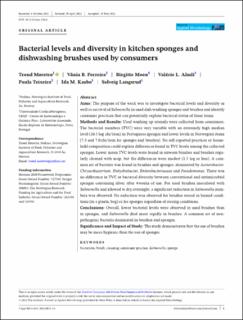| dc.contributor.author | Møretrø, Trond | |
| dc.contributor.author | Ferreira, Vânia B. | |
| dc.contributor.author | Moen, Birgitte | |
| dc.contributor.author | Almli, Valerie Lengard | |
| dc.contributor.author | Teixeira, Paula | |
| dc.contributor.author | Kasbo, Ida Mailen | |
| dc.contributor.author | Langsrud, Solveig | |
| dc.date.accessioned | 2022-06-28T07:05:00Z | |
| dc.date.available | 2022-06-28T07:05:00Z | |
| dc.date.created | 2022-06-27T13:05:03Z | |
| dc.date.issued | 2022 | |
| dc.identifier.citation | Journal of Applied Microbiology. 2022, . | |
| dc.identifier.issn | 1364-5072 | |
| dc.identifier.uri | https://hdl.handle.net/11250/3001184 | |
| dc.description.abstract | Aims: The purpose of the work was to investigate bacterial levels and diversity as well as survival of Salmonella in used dish washing sponges and brushes and identify consumer practices that can potentially explain bacterial status of these items.Methods and Results: Used washing up utensils were collected from consumers. The bacterial numbers (TVC) were very variable with an extremely high median level (10.3 log cfu/item) in Portuguese sponges and lower levels in Norwegian items (7.3 and 7.0 cfu/item for sponges and brushes). No self- reported practices or house-hold composition could explain differences found in TVC levels among the collected sponges. Lower mean TVC levels were found in unworn brushes and brushes regu-larly cleaned with soap, but the differences were modest (1.5 log or less). A com-mon set of bacteria was found in brushes and sponges, dominated by Acinetobacter, Chryseobacterium, Enhydrobacter, Enterobacteriaceae and Pseudomonas. There was no difference in TVC or bacterial diversity between conventional and antimicrobial sponges containing silver after 4 weeks of use. For used brushes inoculated with Salmonella and allowed to dry overnight, a significant reduction in Salmonella num-bers was observed. No reduction was observed for brushes stored in humid condi-tions (in a plastic bag) or for sponges regardless of storing conditions.Conclusions: Overall, lower bacterial levels were observed in used brushes than in sponges, and Salmonella died more rapidly in brushes. A common set of non- pathogenic bacteria dominated in brushes and sponges.Significance and Impact of Study: The study demonstrates that the use of brushes may be more hygienic than the use of sponges. | |
| dc.language.iso | eng | |
| dc.subject | Bakterier | |
| dc.subject | Bacteria | |
| dc.subject | Cleaning | |
| dc.subject | Cleaning | |
| dc.subject | Forbrukerpraksis | |
| dc.subject | Consumer practice | |
| dc.subject | Brush | |
| dc.subject | Brush | |
| dc.subject | Salmonella | |
| dc.subject | Salmonella | |
| dc.title | Bacterial levels and diversity in kitchen sponges and dishwashing brushes used by consumers | |
| dc.title.alternative | Bacterial levels and diversity in kitchen sponges and dishwashing brushes used by consumers | |
| dc.type | Peer reviewed | |
| dc.type | Journal article | |
| dc.description.version | publishedVersion | |
| dc.source.pagenumber | 14 | |
| dc.source.journal | Journal of Applied Microbiology | |
| dc.identifier.doi | 10.1111/jam.15621 | |
| dc.identifier.cristin | 2035400 | |
| dc.relation.project | Nofima AS: 201704 | |
| dc.relation.project | EC/H2020/727580 | |
| dc.relation.project | Norges forskningsråd: 296083 | |
| dc.relation.project | Nofima AS: 12970 | |
| dc.relation.project | Norges forskningsråd: 262306 | |
| dc.relation.project | Nofima AS: 11897 | |
| dc.relation.project | Norges forskningsråd: 314743 | |
| dc.relation.project | Nofima AS: 202104 | |
| cristin.ispublished | true | |
| cristin.fulltext | original | |
| cristin.qualitycode | 1 | |
